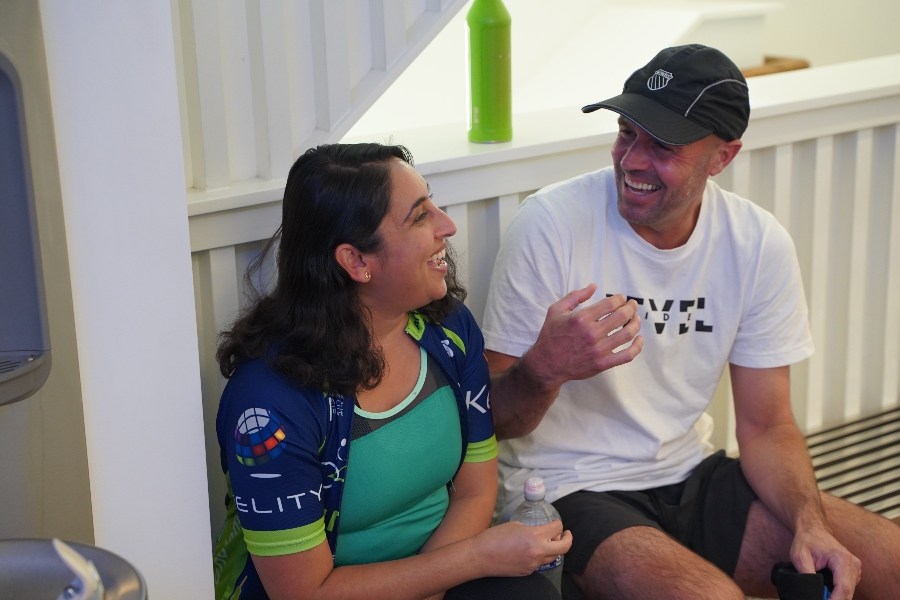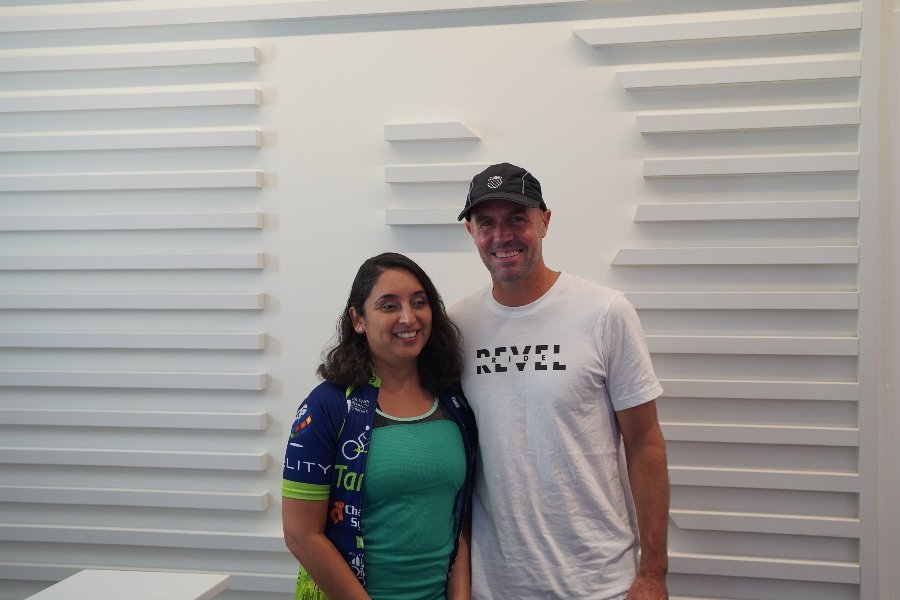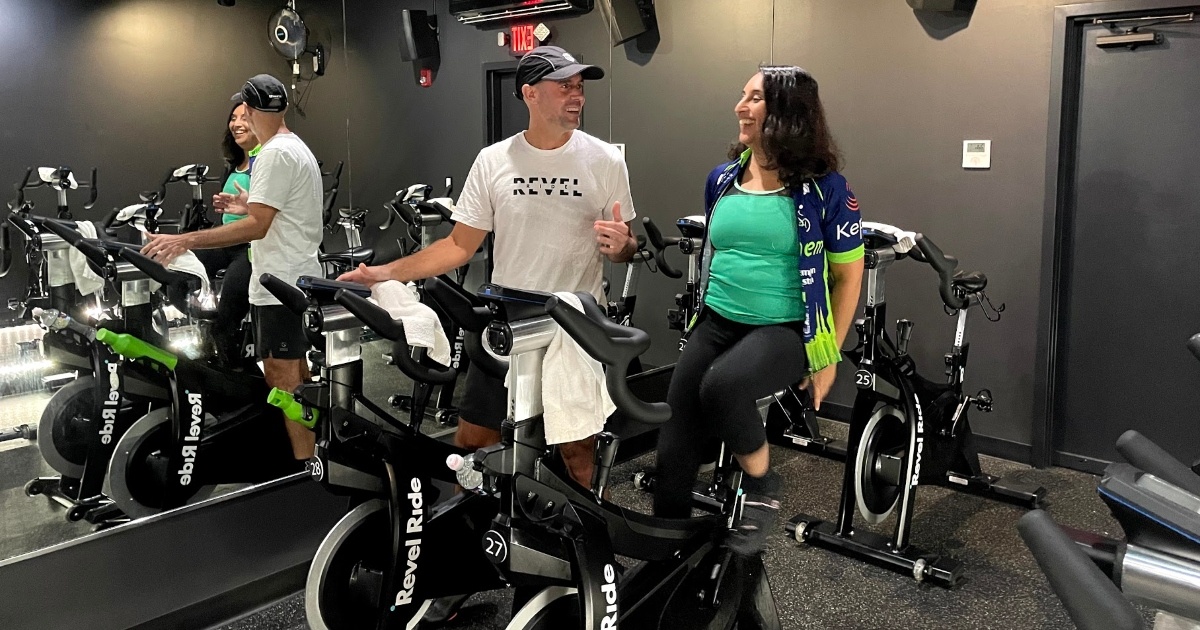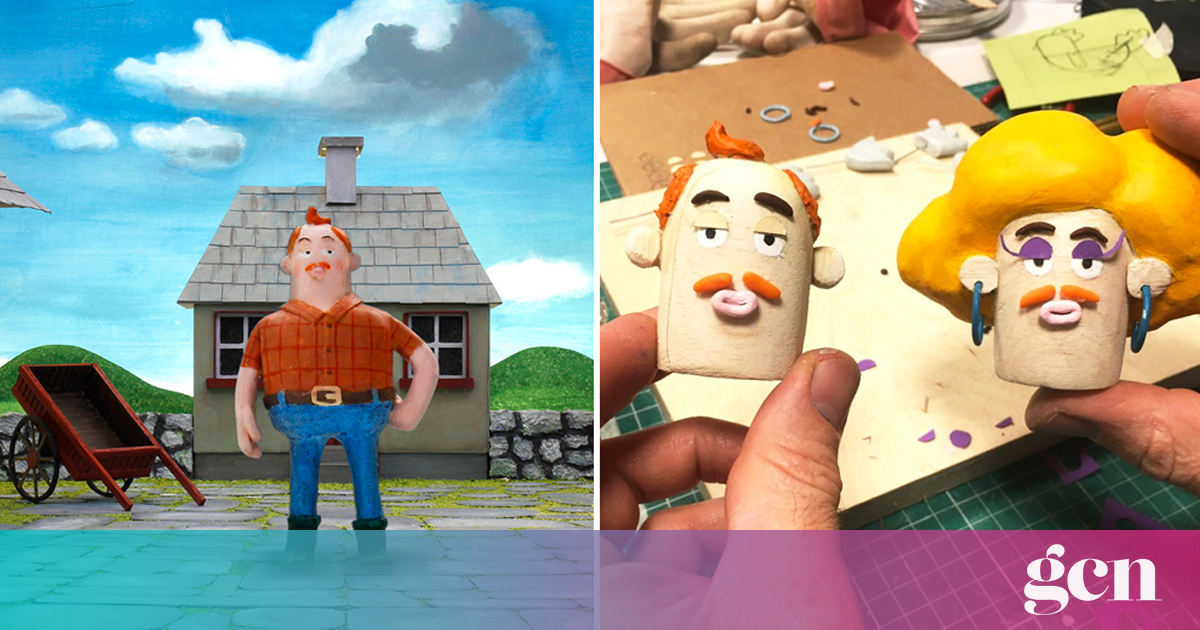Questions and answers
Blind rider Jasmin Sethi works with future Revel Ride instructor Richard Brandon to communicate speed, resistance and riding positions in real time.
Local spinners Richard Brandon and Jasmin Sethi worked together to make the class at Revel Ride more accessible for Sethi, who is blind. / Photograph by Laura Brzyski.
Recent research has found that 81 percent of people with disabilities don’t feel welcome in fitness spaces.
These findings prompted some action to be taken – Degree Deodorant launched #TrainersForHire, a hybrid database campaign encouraging fitness brands to hire trainers living with a disability, while Planet Fitness announced it would expand its gym equipment to include accessible machines. The SoulCycle site in Dedham, Massachusetts recently began running bi-weekly American Sign Language interpretation classes for deaf bikers. And here in Philly, there are a bunch of sports organizations focused on adaptive fitness.
But two local spin enthusiasts recognize that more improvements can be made in gyms, and they are taking matters into their own hands to make indoor cycling a little more accessible.
Revel Ride client Jasmin Sethi and Revel Trainee Instructor Richard Brandon – who live in Washington Square West and The Graduate Hospital, respectively – implemented tactile signage to represent the ride metrics that appear on bike consoles computerized studio.
Why? Sethi lives with retinitis pigmentosa, a rare genetic condition that caused vision loss as a child.
While this did not deter Sethi from achieving academic and professional achievements – she achieved a perfect score of 1600 on her SATs, simultaneously earned a doctorate. and a Harvard JD in a total of six years, and founded his own financial services consulting firm, Sethi Clarity Advisers. ) and resistance, as well as hearing the changes in position of the bike over the music.

Brandon uses a manual touch code to help Sethi know the metrics and the driving positioning. / Photograph by Christian Betlyon.
We chatted with Sethi and Brandon to learn more about their ‘Morse Code’ as they call it, what they learned from their collaboration, and how they think the local fitness industry could make workouts mainstream. more accessible to all customers.
How did you start to work together?
Seti: Exercise has always played a big part in my daily routine. When I moved from New York to Philly last October, I found Elevate Health & Performance (where I go for my strength training) and Revel Ride, which I started going after the studio reopened in March.
When I went to my first Revel class I was basing my ride on what my body was feeling because the other spin studios I had been to didn’t have the computer consoles that track things like your RPMs, your resistance. and your watts. I mentioned to Jamie [Promislo, owner of Revel Ride] once soon enough it would be helpful to have someone to comment on what my screen is showing because I wanted to be more responsible as I don’t have access to those comments. I thought having someone to help me would help me get a better idea of, say, what 110 RPM looks like, and then my muscles would start to remember over time.
Brandon: I’ve been riding Revel pretty much since they opened three years ago. When I saw Jasmin take his first tour in the studio, I was like, “Wow, that must be a challenge” because spinning can be difficult, even for someone who has his vision. So I mentioned to Jamie [Promislo] to let me know if Jasmin has ever said she needs help with anything. One day, about four or five months ago, I arrived at the studio and Jamie told me that Jasmin wanted to be held more accountable during class because she couldn’t see the metrics that appear on the console. I said I would absolutely help him, and we took him from there.
How did you know where to start?
Brandon: I didn’t have a plan to start with and I don’t have any sort of certification or training to do something like this. But Jasmin and I worked together to create a few basic signals that would help guide her through her journey. We designed this organically, starting with one rule of thumb: Jasmin wanted to improve in rotation, but she couldn’t see the console. We built from there.
What are these signals?
Seti: What we do is a bit like Morse code. Richard automates the screen to help me do what I’m supposed to do in class. If he sees that my RPMs are lower than they should be, he will pat my leg for more speed. If I look like I can take more resistance, he’ll pat my arm.
Brandon: Exactly. The first two signals we implemented were to tap his bicep for more resistance and tap on his thigh for more speed. We only used these two signals until she hit her first goal of hitting 120 RPM in class. [with the designated resistance added]. As she progressed we added more signage to help her move more easily on the bike. There is a layer of difficulty for her when it comes to changing positions, mainly if the signals are not clearly spoken or loud enough on the music. So we found signals for where she should be on the bike: one finger at the base of her back for the first position (in the saddle), two fingers in the middle of her back for the second position (standing) and three fingers. at the base of his neck for the third position (bent at the waist, flat back, hands extended to the ends of the handlebars).

Sethi and Brandon before class at Revel Ride. / Photograph by Christian Betlyon.
How do you feel now as a rider, Jasmin?
Seti: Right now I have a much better idea of the speed, but also of how the instructors teach. I recognize that it is difficult for the instructors to say everything and to project themselves on the music. I asked some of them to project a little more or to be a little clearer with their clues, and they were very receptive. Small adjustments like this can get more people on the course.
So is the ultimate goal to completely remove signage?
Seti: I think it’s good to build lasting routines, especially when it comes to fitness and wellness. Also, I’m the type of person who wants to be able to do things on my own. One of the advantages of spinning – over other group training classes – is that it is a little easier [for me] to be continued as there is a limited set of movements. Once you know the teaching style of an instructor and your body begins to recognize the sensation of certain resistance, you may not need as much feedback. I think it’s good if I get to the point where I can do it all on my own, especially when Richard is on the road [for work] or teach a class himself.
Richard, you mentioned that you don’t have formal training in adaptive fitness. How did your experience of working with Jasmin influence your training to become a spin instructor?
Brandon: Riding with her is a real participation in someone else’s classroom experience. When I train to be an instructor, I train like I’m riding with her. For example, when I first started working with Jasmin, I tried to do what she does: get on the bike and ride – at least to a song – with my eyes closed. It all really comes down to clean and fairly impeccable instruction. I tried to keep in mind that every instruction I give [during training] is clear, and every move I expect from my runners is described in detail so that everyone in the class understands and can be successful.

Sethi and Brandon at Revel Ride. / Photograph by Christian Betlyon.
Jasmin, based on your background and our conversation, you seem quite outgoing, curious, and ready to try new things. But going to a new fitness studio or wellness area can be intimidating, and I can imagine it could be even bigger for someone with a disability.
Seti: I am definitely someone who takes initiatives but who recognizes that everyone is not like that. I also believe that people need to take risks, come forward and try something at least once to see what they’re capable of and if there is support for them there. The instructors at Revel have been great, and my personal trainer at Elevate is quite handy and will redirect hand positions or shift my body if I’m not doing a movement properly.
But I also experienced unwelcoming situations with people who didn’t want me there – maybe they felt ill-equipped, scared or overwhelmed. I once went for a walk around town with a dating group, but the manager said they didn’t want a blind person walking around. I am able to take a leisurely walk and may need help from time to time. I was disappointed because I really wanted to walk, but I also didn’t want to be around such a rigid and contemptuous person from the start. But in the end, I’m a pretty pragmatic consumer, and I have the freedom to choose anyone or elsewhere. I’m not going to gain anything by trying to change someone who isn’t going to budge.
What do you think the local fitness community can do better or more to ensure that everyone who walks through their door feels welcome and able to complete a workout?
Seti: I can only speak from a blind person’s perspective so I can’t say the same is true for other disabilities but it would be great if a studio owner or instructor is open minded at least small adjustments. People may often think they need to make major changes, when in fact, they probably don’t. I’m a firm believer in the idea that making a few small adjustments – especially in a community setting – can go a long way, help people be better communicators, and lead to greater inclusion.




